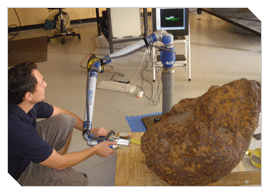

In October 2008, “meteorite hunter” Steve Arnold visited Direct Dimensions with a really unique 3D problem. He owned a huge rare meteorite that he hoped to sell at auction. Meteorites are space debris which enter the earth’s atmosphere, and occasionally make it to the earth’s surface. Arnold claimed that at 1,400 pounds, this was the largest “oriented pallasite” meteorite ever found on the planet.
Pallasites are a combination of iron and olivine (olivine is also known as the semi-precious gemstone peridot) and are very rare meteorites; only 61 have been discovered on the earth (10 of which were located in Antarctica). An “oriented” pallasite, meaning that its curved shape came from driving straight through the earth’s atmosphere rather than breaking apart upon atmospheric contact, is even rarer.
The meteorite was further described by geologist Tim McCoy, the curator of meteorites for the Smithsonian Institution, as “a nice collector piece or museum piece.” He went on to say that it was probably 4.5 billion years, older than anything found on earth, and was therefore especially useful for scientists studying our solar system.
Arnold and his meteorite were on their way to New York City for the auction and passed thru Direct Dimensions in Baltimore. In the likely event that he would sell the meteorite to a private collector rather than a public institution or museum, Arnold wanted it precisely digitally captured in 3D for archival documentation and research purposes that might arise in the future.
Direct Dimensions’ technician Jon Wood spent a full day scanning the huge space rock with a laser line scanner mounted on a Faro Arm to capture the exact shape and contours down to fractions of a millimeter. Then over the next few days using Innovmetric’s PolyWorks Modeler software, Wood processed the raw scan data into a perfect digital replica, which could be used later for scientific analysis or possibly even to reproduce the meteorite – physically.
In addition, the digital model can also be used for 3D visualizations and animations – perhaps by a researcher to show how the meteorite remained intact thru the atmosphere and upon impact. By having the meteorite documented using 3D laser scanning, Arnold ensured that its unique shape and features would be available digitally for research even if it were purchased by a private collector and withdrawn from public view.